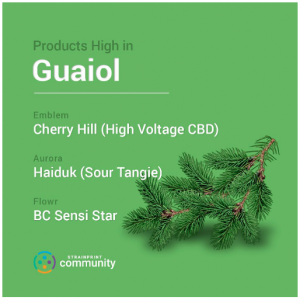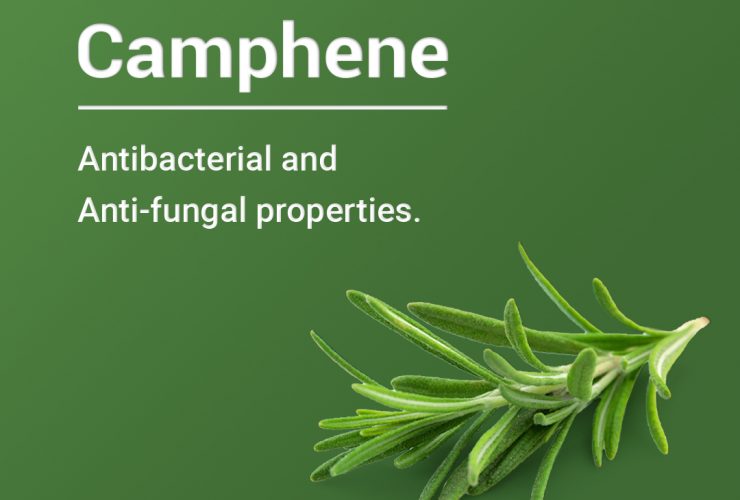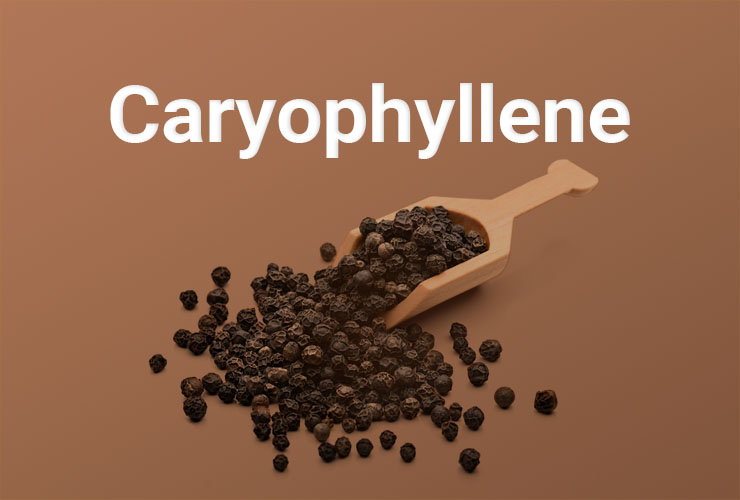Understanding Terpenes: Guaiol

Written by
Welcome to the Strainprint Community Cannabis Terpenes Series. Before diving into the details behind guaiol, the multi-talented terpene produced by cannabis known for its anti-inflammatory and anti-fungal properties (making it effective in fighting bacterial infections), it behooves readers to develop a solid understanding of terpenes as a category of wellness molecule.
Patients gain advantage by knowing how terpenes compare to the other group of healthy chemicals produced by cannabis called cannabinoids (including tetrahydrocannabinol [THC] and cannabidiol [CBD]). The first article in the series, featuring the terpene myrcene, offers a great primer on terpenes, and cannabinoids; you can gain more understanding here.
Understanding Guaiol
Guaiol (pronounced “gweye-all” and sometimes called champacol) is a terpene that conveys an aroma of pine that is described as featuring fragrant undertones of wood and rose. Like other terpenes, this medicinal molecule is produced by many plants other than cannabis, including cypress pine and guaiacum (an evergreen tree of the Caribbean and tropical America).
This special terpene is rich in health benefits and has been employed throughout history to treat conditions such as arthritis, gout, and sore throat. One of its most promising efficacies is its ability to decrease systemic inflammation, making it a potentially effective part of the treatment regimen of literally hundreds of diseases and conditions, including cancer and fibromyalgia.
Guaiol is also employed as an insect repellent and insecticide. Cannabis cultivars rich in this terpene include BC Sensi Star from Flowr, Blue Kush, Cherry Hill High Voltage from Emblem, Chocolope, Haiduk (Sour Tangie) from Aurora, Kali Dog, Liberty Haze, Sour Diesel, Royal Gorilla, and White Widow.

Similar to its cousin, the terpene ocimene, guaiol features a relatively low boiling point of only 198° F (92° C). This means that patients consuming it via the vaporization of cannabis flowers must employ a low temperature setting to gain the maximum benefit from this volatile terpene.
Medicinal Efficacy
The efficacy conveyed by guaiol is similar to that of other terpenes, with its greatest health benefits being anti-inflammatory and antimicrobial in nature. This powerful terpene is adept at treating conditions as diverse as arthritis, constipation, gout, sore throat, and even syphilis.
Guaiol has a history of being used as a diuretic, meaning it can lower blood pressure. Like many other terpenes and the major cannabinoids cannabidiol (CBD) and tetrahydrocannabinol (THC), it has been shown to exhibit analgesic (pain killing) properties. Guaiol has also been employed for centuries to treat coughing.
The Studies
A 2016 study entitled “Guaiol Regulates RAD51 Stability via Autophagy to Induce Cell Apoptosis in Non-small Cell Lung Cancer” that was published in the journal Oncotarget found that guaiol is an effective agent against cancer cells, resulting in their apoptosis (a form of genetically pre-programmed cellular death in which cancer cells basically commit suicide).
Reported the study’s researchers, “Guaiol is involved in cell autophagy to regulate the expression of RAD51, leading to double-strand break-triggered cell apoptosis.” The in-vitro study concluded, “Our studies provide an attractive insight in applying guaiol into [non-small cell lung cancer] treatments and further suggest that knockdown of oncogenic RAD51 will greatly enhance the chemosensitivity of patients with [lung cancer].”
A 2017 study entitled “The Essential Oil from the Fruits of the Brazilian Spice Xylopia Sericea A. St.-Hil. Presents Expressive In-vitro Antibacterial and Antioxidant Activity” and published in The Journal of Pharmacy and Pharmacology found guaiol to be effective in treating bacterial infections. The research revealed that this terpene may be useful as an antimicrobial ingredient in food preservation.
Reported the researchers, “[Guaiol] presented a significant antioxidant activity and also a high bacteriostatic effect against staphylococcus aureus, enterobacter cloacae, bacillus cereus, and klebsiella pneumoniae.” Concluded the study, “Those results evidenced the potential of [guaiol] to treat human bacterial infections and as an antimicrobial ingredient for food preservation.”
A 2013 study entitled “Guaiol—A Naturally Occurring Insecticidal Sesquiterpene” that was published in the journal Natural Products Communication found this terpene to be a powerful insecticide.
Concluded the researchers, “Guaiol showed significant inhibition of aphids at a concentration of 70 mg/L. It also showed good contact activities against the 4th instar larvae of Mythimna separate and 3rd instar larvae of Plutella xylostella…”
A 2007 study entitled “Microbial Transformation of Guaiol and Antibacterial Activity of its Transformed Products” and published in the Journal of Natural Products revealed the anti-fungal and antibacterial properties of guaiol.


